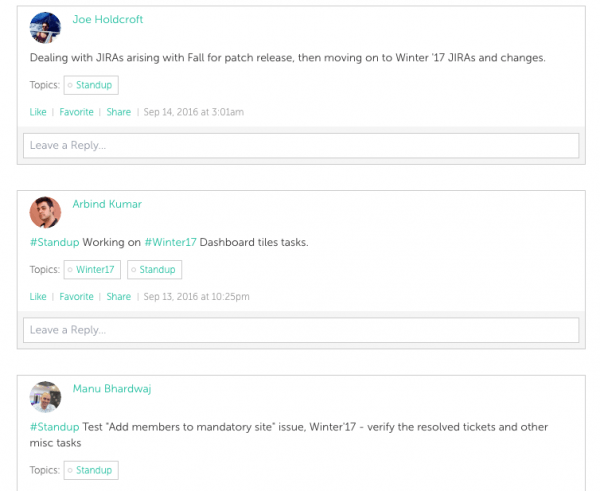Transparency is a core company value at Simpplr. Our goal is to share as much information as possible amongst ourselves so we can all be more effective.
We want to better understand how each person is contributing to our combined success, and make sure that every member of the team in every location is up to date on the most important announcements and information.
This last point is arguably the most important, because we’re set up just how you wouldn’t choose to organize a growing start-up. We’re only twenty-six people, but we’re spread out globally – which creates some advantages, but also some sizable challenges in communication and collaboration.
Our CEO and HQ are in Silicon Valley, which houses our customer success and support teams. Product development and the engineering team are based in India, along with our CTO and co-founder. Our user experience and front-end design team is based in London, while our sales team is spread across San Francisco, Sacramento and the South Bay. The great valley mythology of a bunch of smart people crammed in a garage in Palo Alto, huddled together and cranking code, making all the important decisions in daily stand-ups – that’s not us.
While working across locations and teams can be a challenge, we’ve developed some methods and approaches that help us be more effective, productive and to enable transparency.
1. We’re dedicated users of our own employee community product
We’ve moved almost all company interactions into our instance of Simpplr, which we call “Backyard,” and we expect all employees to use Backyard for communicating every day. To understand our own user behavior, we review and publish user statistics regularly, including a month-end summary shared with all employees.
In spite of his best efforts, our CEO Dhiraj Sharma is not the most active user. In truth, it’s not critical for the CEO to be number one, but when senior leaders in the organization use the app they lead by example and model the culture and behavior for the rest of the company. What’s much more important is that the rest of the team is actively using Simpplr, communicating with the entire company and finding value. This holds true for any employee community or intranet project.

2. Sharing the daily stand-up
While the idea of a daily meeting is second nature for most development and software organizations, we’ve moved our check-ins into Backyard. Everyday all employees post a quick update on where they’re focused and what they’re trying to get done for the day.
Whether it’s following up on new leads, clearing Jira tickets or prepping for a customer go-live, every employee can see where their colleagues are focused and how they’re contributing. The tangible impact includes quick knowledge sharing and problem identification, and also begins to connect individual expertise with day-to-day activity.
3. Mandatory Monday Operations Meetings
For the all our team leaders there’s only one mandatory meeting – the Monday morning Ops meeting. We’re committed to limiting it to one hour, so there’s a standard agenda that begins with a status update from prior meetings on key deliverables. In addition, all team members are expected to update a standard slide deck before the meeting using Google Docs, so we keep a running record of progress while ensuring that we raise and tackle key issues and focus discussion, and all key deliverables have owners attached to them.
4. Rotating the Meeting Chair
One of our core goals in the Ops meeting is to get input from everyone on the team. With ten people in the meeting, this is a challenge that’s further amplified by the fact that we’re dialing in from three different time zones.
Over time, we noticed that we weren’t hearing from everyone consistently. In any operational meeting there’s often a bias to defer to the most senior person. Some people are more vocal and extroverted, so they’re more likely to be heard in a big forum. Another potential influencing factor is cultural. We have a big group working from India, where team members often defer to their boss or the senior leader in a meeting.
To address this challenge head-on, we moved to a rotating chairmanship. Each week a different person on the team takes the lead in calling the meeting to order and driving the agenda. This change has helped us hear from everyone, better understand each team’s unique contributions, and strengthened everyone’s operational understanding. As a result we’re all more comfortable asking questions and trying to understand the challenges we face to deliver quality products and satisfy customers.
5. Our default conference video setting is “On”
In-person meetings are always more productive than phone calls, but we don’t have that luxury for our Ops meetings (or a lot of other small and large group discussions.) As a result, we’ve moved to default “video on” for conference calls as a company. Now when we kick off our Zoom meetings we can see each other, which goes a long way in communicating more effectively. And when you can see other team members looking at you, you’re much less likely to give in to other distractions.
6. Weekly Company Updates
Finally, we make a point to send a weekly company-wide round up. Recently, we’ve been trying to raise venture funding, so we’ve included updates on the process along with feedback we received from the venture community. We want all employees to stay updated on customer feedback, new customers, open tickets, go-live status and new team members.
Providing a weekly update in Simpplr helps keep everyone aligned with top priorities, communicates company concerns and celebrates milestones. It also gives us a regular chance to celebrate customer wins and strong performances by individual members of our team.
We package the update and promote it on our Simpplr home page. In addition, we use the newsletter feature in Simpplr to send out a company email, so all users get an email with the headline of the update, and when they click they’re taken directly to the article in Backyard.
Transparency can be a challenge, but to bring its value to life at Simpplr we’re working to align our operational processes to make transparency a daily part of the way we work. We’d love to hear from you on any transparency best practices – and if we can help your company communicate and enable a transparent culture, please contact us to get more information, a demo or even a customized trial of Simpplr.














